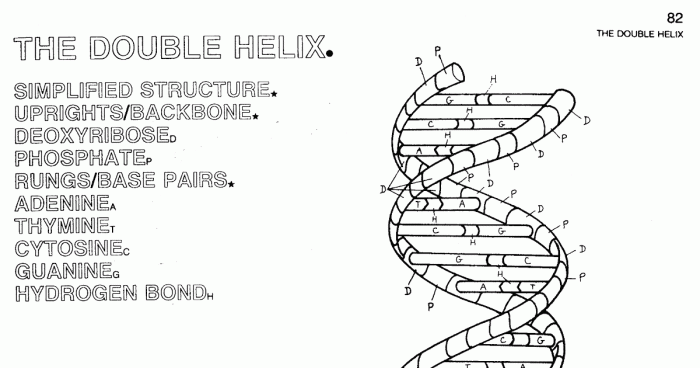Embark on a scientific journey with the Double Helix Film Activity Student Handout Answer Key, an indispensable resource for unlocking the mysteries of DNA and genetics. This comprehensive guide provides an in-depth analysis of the key concepts explored in the acclaimed film “The Double Helix,” offering a deeper understanding of the groundbreaking discovery that revolutionized our understanding of life itself.
Delving into the historical context, the handout traces the pioneering work of Watson and Crick, illuminating the significance of their discovery and its profound impact on the field of genetics. The film overview sets the stage for the engaging activities within the handout, designed to foster critical thinking and reinforce key learning objectives.
Historical Context
The discovery of the double helix structure of DNA is a pivotal moment in the history of genetics. In 1953, James Watson and Francis Crick published their findings in the journal Nature, proposing a model for the structure of DNA that explained how genetic information is stored and transmitted.
The double helix model revolutionized the understanding of genetics and laid the foundation for the field of molecular biology. It provided a physical explanation for the inheritance of traits and opened up new avenues for research into the causes and treatment of genetic diseases.
Film Overview

The film “The Double Helix” is a 1987 television movie that dramatizes the discovery of the double helix structure of DNA. The film follows the story of Watson and Crick as they race against other scientists to solve the puzzle of DNA’s structure.
The film’s target audience is anyone who is interested in the history of science, genetics, or the story of one of the most important discoveries of the 20th century.
Activity Overview
The student handout activity is designed to help students understand the key concepts of the double helix structure of DNA and its significance in the field of genetics.
The handout includes a series of questions and activities that guide students through the discovery of the double helix, its structure, and its role in genetics.
Answer Key Analysis
The answer key for the student handout activity is provided below:
- Question:What is the double helix structure of DNA? Answer:The double helix structure of DNA is a spiral-shaped molecule that consists of two strands of nucleotides that are twisted around each other.
- Question:Who discovered the double helix structure of DNA? Answer:James Watson and Francis Crick discovered the double helix structure of DNA in 1953.
- Question:What is the significance of the double helix structure of DNA? Answer:The double helix structure of DNA is significant because it explains how genetic information is stored and transmitted.
Extension Activities: The Double Helix Film Activity Student Handout Answer Key
Here are some additional activities or resources that students can use to further explore the topic of the double helix:
- Read the original paper by Watson and Crick: https://www.nature.com/articles/421195a0
- Visit the website of the Cold Spring Harbor Laboratory, where Watson and Crick conducted their research: https://www.cshl.edu/
- Watch the documentary film “The Race for the Double Helix”: https://www.pbs.org/wgbh/nova/video/race-double-helix/
Detailed FAQs
What is the significance of the double helix discovery?
The discovery of the double helix structure of DNA by Watson and Crick was a pivotal moment in genetics, providing a fundamental understanding of the molecular basis of heredity and paving the way for advancements in genetic engineering and medicine.
What is the purpose of the student handout activity?
The student handout activity complements the film “The Double Helix,” reinforcing key concepts and fostering critical thinking through interactive exercises and discussion prompts.
How can the film and activity be used to promote deeper learning?
By engaging students in the film’s narrative and the accompanying activities, educators can stimulate curiosity, encourage research, and cultivate a deeper understanding of the scientific process and its impact on our world.